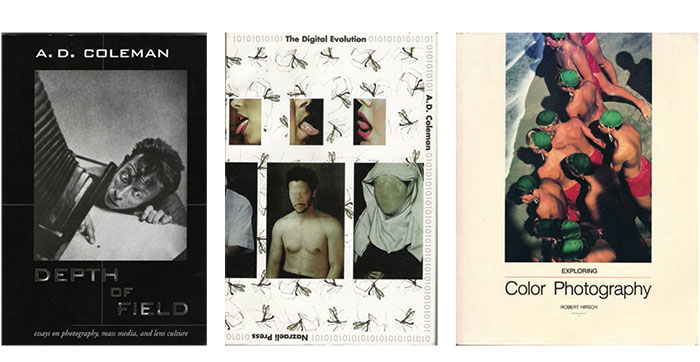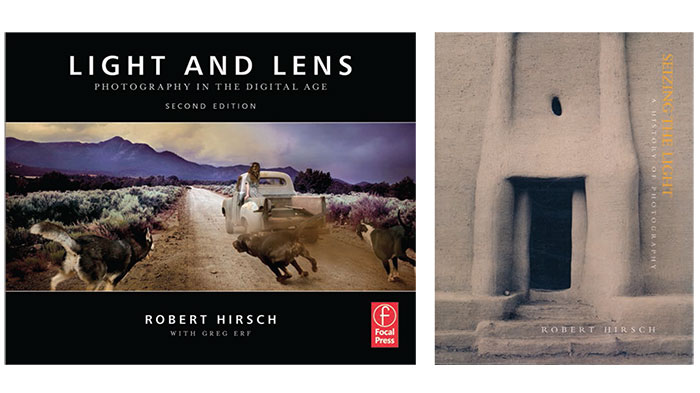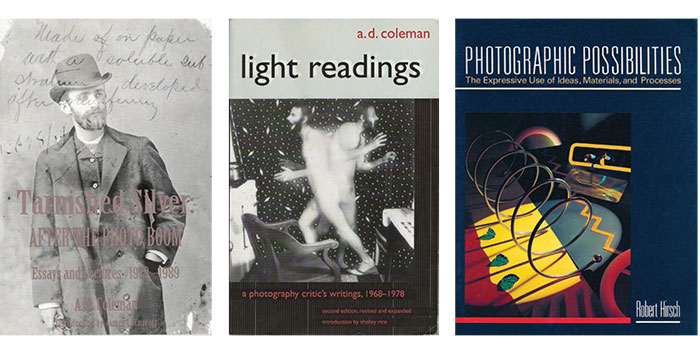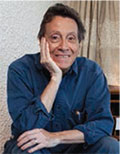
A Conversation About Photography
A. D. Coleman and Robert Hirsch
Photo Technique, November/December 2013
By Robert Hirsch
We asked two of our favorite writers and well-respected critics of photography to get together to talk about photography. Here are some topics, thoughts and talking points from their discussions.
On their personal introduction to photography.
Robert Hirsch: I learned the rudiments of photo- graphy from my dad in his basement darkroom at age 11. This set me on the path of earning my BFA from Rochester Institute of Technology and MFA from Arizona State University and pursuing a life in the field as an imagemaker, curator, gallery director, professor and writer.
A. D. Coleman: My introduction to photography as a serious creative medium and communication system came in my 20s, working as an assistant editor in a publishing house that had a line of photo books. The thinness of the literature at that point, the ab- sence of a critical dialogue, surprised me. Culture abhors a vacuum; I thought I might have something to contribute.
About their experience first writing/critiquing.
RH: I am an accidental writer with no formal edu- cation in the field. As a professor of photography in the mid-1980s, I received a book designed to instruct people about color photography. I was so frustrated by its parochial approach and uninspiring content that I threw it into the trash and said, “I can do better than that.” In the ensuing 30 years, I am still trying to write “better than that” from a maker’s perspective.
ADC: People in the field were unaccustomed to the presence of a working critic, and xenophobically suspi- cious of any writing about the medium not done by a photographer. Over time they got used to me, and those who came after me, but it was strange all around, especially in the late ’60s and early ’70s. I had no long-range plan when I started, certainly no expectation that I’d still be at it 45 years and several thousand essays later. It’s an extremely passive readership, which I didn’t anticipate. With that said, writing about photography has sustained my interest for all these years, despite the absence of a supportive readership, the erratic income, the fluctuating availability of periodicals interested in such material.
Discussing new work, genres & criteria.
RH: I am a bit of a contrarian and thus lean towards inventive makers who expand the “window-on-the- world” and fine-print practices of traditional photo- graphic training. My latest project, Transformational Imaging: Handmade Photography Since 1960 is due to be published in 2014 by Focal Press. The book deals with artists who interact with the camera capture to shape their own interpretation of reality, reminding us that all photographs are constructions. Regardless of the genre, I do my best to explain how photographs affect me, to provide a pathway for my readers to find their own meaning in the work. This approach can unlock unseen windows that open hidden viewpoints and perceptions that we instantly recognize as our own, but could not have previously expressed without someone else first pointing the way.
ADC: The focus of my work has shifted over time: several phases of intensive reviewing (with the em- phasis always on new work by younger/emerging figures) and event reportage, more scholarly passages, nowadays a concentration on informed cultural journalism about the medium. I stopped reviewing exhibitions and books in the late ’90s. I don’t see much new work that excites me. Now and then I come across something that provokes me; sometimes I’m invited to create a monograph introduction, or I curate an exhibition and provide a contextualizing essay.
As a critic, I’m most interested in images whose con- tent the photographer determines, made for other than commercial purposes. So I’ve prioritized work in the fine-art, documentary and photojournalistic modes, along with amateur (mostly autobiographical) imagery−the family album, etc. But from time to time I’ve written about fashion, advertising and scientific photography, pretty much the entire range of what some call vernacular or applied photography, as well as my primary areas of concern.

On the rise of digital photography & camera phones.
ADC: I’ve written about digital imaging and elec- tronic communication systems since 1967. My 1998 book The Digital Evolution: Visual Communication in the Electronic Age collects the cream of those observations from three decades. I’m working on a second edition, much expanded, to bring that project up to date.
Digital forms enable the production, storage and trans- mission of images without the production of objects. That’s the primary paradigm shift−the dematerialization of the image. Digital tools also make it easy to perform a number of tasks that were difficult if not impossible using analog tools. And digital technology contains options unavailable in analog forms: cameras that see around corners, cameras that make pictures whose viewers decide what’s in the foreground and what’s in the background.
On the impact digital photography has made on photojournalism, and surveillance camera footage such as those used to track the Boston bombing suspects.
RH: Digital imaging has allowed more people than ever to realize Henry Fox Talbot’s dream of “every man being his own printer and publisher” and of “poor authors [making] facsimiles in their own handwriting” to get around the established gatekeeping machinery of how images are made, circulated and understood. The result is a torrent of direct, unfiltered images that are wide open in terms of usage, changeability and interpretation, a situation that calls out for curators to give context to and make sense out of this abundance of images.
Another factor to take into consideration is how the meaning of photographs is contingent upon their surrounding context, especially when combined with text and/or commentary to direct viewers to a particular conclusion. The camera-is-in-our-pockets phenomenon has enabled ordinary people to act as amateur photojournalists (aka-citizen journalists), following the old news adage of “f/8 and be there,” thus capturing newsworthy scenes that previously would have gone unrecorded.
We hope these individuals possess the integrity to deliver unmitigated images, but they are not under any obligation to follow professional standards and may even have a horse in the race. Therefore, their reliability and motivations should be examined before we accept them as dependable surrogate witnesses, based on the compact that has evolved between photojournalists and viewers in terms of what people expect news photographs to deliver. To compete, professionals must use their skills to add complexity and depth to their picture stories on a daily basis. To survive, news organizations need to embrace the non-linearity resulting from the hybridization of media that encourages ongoing participation by others to interpret and analyze events.
ADC: Ever since the medium’s invention in the 1830s, we’ve talked about the democratizing aspect of photography, how it makes visual communication accessible to everyone. We’ve finally seen that start to happen. Just about anywhere I find myself nowadays−the States, Canada, Latin America, China, Europe−I can see that many of the people around me are carrying cameras and using them on a regular basis to make images that they’ll save for themselves and share with other people. That’s the democracy of images in the digital world.
In that environment, which has become pervasive, we’re increasingly likely to end up visible in other people’s pictures, even if just coincidentally. And they’re likely to end up in ours. We’re under sur-veillance by each other, especially at public events in public spaces. We also watch ourselves and those close to us, and broadcast images of ourselves to others. Surveillance or security cameras have simply become a component of this observational culture we’ve evolved.
Of course this affects photojournalism. The technical quality of the images one can make with even a decent cellphone camera, combined with their ease of use, transmissibility and the increased visual sophist- ication of the populace, makes each of us a potential “citizen journalist.” That makes life harder for the professional photojournalist, who has to compete with all these newbies, but it brings us images we’d otherwise never see from eyewitnesses to and participants in important events.

Robert, you raised the question of the credibility of photographers as witnesses. What about the reliability of the photograph itself as a document in the digital era?
RH: Digital imaging calls attention to the fact that all photographs are human creations founded on the Renaissance three-point perspective model. For me there are no “neutral” photographs, as even NASA’s unmanned spacecraft images are the result of a human programmer’s perspective, how they are interpreted and the context in which they are seen.
What interests me are makers who propel the medium’s evolution by engaging in artistic “troublemaking” through expanding and transforming their subjects beyond the boundaries of what has been thought to represent photographic reality. This merges into how technological advances revise our notions of photographic reality. Digital’s nonlinear nature that involves more than a single dimension allows makers to infuse their images with layers of experiences and time, which then challenge viewers to look more deeply and see beyond customary storytelling structures and frozen “Decisive Moments” of time.
I am excited by artists who delve beneath the surface and link the visible to the invisible as a multifaceted means of looking inside an experience. Such an approach posits that the reliability of images is depend- ent on combining the outer appearance of a subjectwith its inner makeup in order to get to the full depth of the experience. This way of visualizing the world acknowledges that life does not follow the seventeenth-century Newtonian notions of representation within a fixed mechanical universe, but rather we live within Einstein’s relativist concepts of multiple realities.

ADC: We’ve come to understand the non-neutrality, the interpretive aspect, of all photographs. With the forms of analog photography most commonly used for purposes of reporting, publication was based on a physical object−a slide, a negative−whose existence verified what the photographer captured. Any post-exposure alteration of the published image could be ascertained with relative ease; any alteration of the original could be detected with a simple magnifying glass.
Digital images and their files are susceptible to more subtle pixel-by-pixel manipulation. Identifying and proving such revisions can require expertise and sophisticated computer programs−not just a keen eye and a loupe. Given how easy it has become to get an image into circulation, even virally, it’s now possible to plant a manipulated image firmly in the public psyche before any correction can catch up with it.
That said, we also have watchful editors and industry-wide sanctions, not to mention a public much more savvy about digital tools than they were about their analog forebears, and ever on the lookout for alter- ed images. Plus an energetic public dialogue about this issue. Vigilance remains necessary, but no one’s gotten away with an influential digital fake for very long.
 |
A. D. Coleman has published eight books and more than 2000 essays on photography and related subjects. Formerly a columnist for the Village Voice, the New York Times and the New York Observer, Coleman has contributed to ARTnews, Art On Paper, Technology Review, Juliet Art Magazine (Italy), European Photography (Germany), La Fotografia (Spain) and Art Today (China). Coleman’s widely read blog, “Photocritic International,” appears at photocritic.com.
Since 2005, exhibitions that he has curated have opened at museums and galleries in Canada, China, Finland, Italy, Rumania, Slovakia and the U.S. © Copyright 2013 by A. D. Coleman. All rights reserved.
By permission of the author and Image/World Syndication Services, imageworld@nearbycafe.com.
|
 |
Robert Hirsch is author of Light and Lens: Photography in the Digital Age, Exploring Color Photography: From Film to Pixels; Photographic Possibilities: The Expressive Use of Equipment, Ideas, Materials and Processes; and Seizing the Light: A Social History of Photography.
Hirsch directs Light Research, a consulting service that provides professional services to the fields of photographic art and education. For more about his projects visit: lightresearch.net.
|
Article Copyright A.D. Coleman and Robert Hirsch, 2013.
|